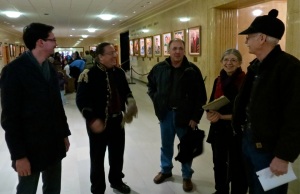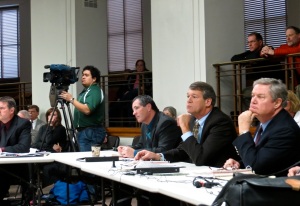01/25/2013
The Killdeer Mountains: Living History and Sacredness

Individuals concerned about what happens to the Killdeer Mountains chat before the public hearing at the Bismarck capitol on January 24, 2013.
On January 24, 2013, at 1:00pm (CST) the public hearing for the Killdeer Mountains was held in the capitol of Bismarck, North Dakota. It was Industrial Commission Case Number 18618 concerning sections 25 & 36, T. 146 N., R. 97 W, this about 30-35 miles north of Dickinson, North Dakota. Originally the hearing was scheduled in the Governor’s meeting room, a rather closed-off and secluded place. Because of the public turn-out, though, the hearing was relocated to the larger Brynhild Haugland room in the western wing of the capitol. I drove over from Fargo to Bismarck to attend the meeting, and while there scribbled down some notes and took some audio-video as well. The high-points, I thought, were in capturing two Native voices from two disparate cultures.
The first is a video from Theodora Birdbear of Mandaree, North Dakota (Mandaree is Mandan, Hidatsa and Arikara territory). The microphone on my Canon PowerShot SX260 HS captured the audio a bit, and just in case there are those of us hard-of-hearing, I provided transcript of Theodora’s testimony below.
Transcript:
…and he expressed the impact of oil and gas development, the industrialization of an area, which impacts the quality of that spiritual experience. I guess it’s kind of equivalent to having an oil well right beside your Catholic church or something. It’s parallel to that. So I wanted the commission to know that Fort Berthold does have a living connection to that area, and to consider that in your decision making. As people have said prior to this, technology is evolving, and to keep it [oil] in the ground is not wasting it. They are going to be after it in the future. What’s the rush? The rush is quick decisions, unplanned decisions, and unplanned impacts. So I just wanted to make a comment about our relationship with that area. It is still living today.

North Dakota Industrial Commissioners listen to Natives speak about the sacredness and history of the Killdeer Mountains.
The other Native voice captured came by way of Dakota Goodhouse, who originally hails from the Standing Rock Sioux Reservation in south-central North Dakota (he shares the namesake of the state, which in English means ally or friend). Dakota gives some backdrop about the history of Killdeer Mountains as it pertains to the US-Dakota Wars, specifically the punitive campaigns carried out by General Alfred Sully west of the Missouri River circa 1864.
For some video context, Dakota is speaking and Lynn Helms is seated at the right. In this video excerpt, Dakota is remarking on how the encampment and battle boundaries are much larger and broader than what is delineated now (as of 01/25/2013), and how they need to be re-considered.

No comments:
Post a Comment